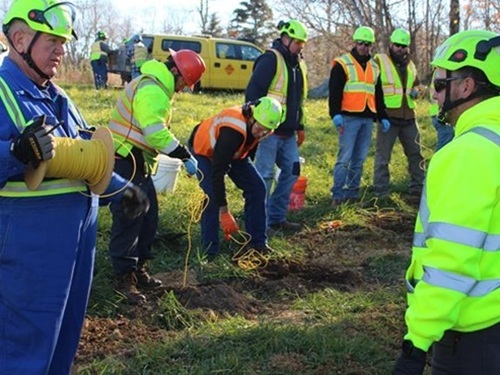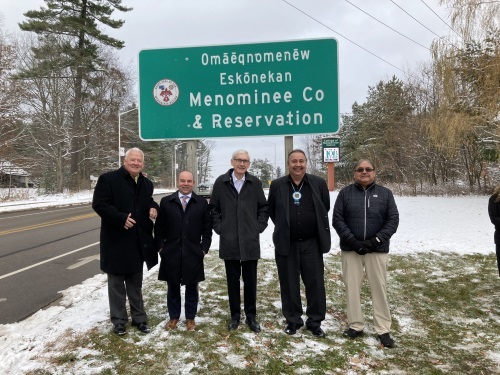Governor Tony Evers (D), the Menominee Indian Tribe of Wisconsin, and the Wisconsin Department of Transportation recently unveiled new dual-language signs for placement on state highways indicating the Menominee Nation’s tribal boundaries and other landmarks in both English and the Menominee Language.
[Above photo by the Wisconsin DOT]
The sign unveiling took place at the Menominee Casino Resort and Convention Center in Keshena and expands on a statewide dual-language sign initiative launched by Wisconsin DOT in 2021 to collaborate with the 12 “Native Nations” residing in Wisconsin to install road signs on tribal lands in both English and Indigenous languages.
It follows a similar unveiling held by the Oneida Nation and the Wisconsin DOT in October.

The Menominee Nation is the third tribe in the state to install dual-language signs, following the Oneida Nation and the Red Cliff Band of Lake Superior Chippewa.
The new tribal boundary signs feature the Menominee Nation seal next to the tribe’s name in the Menominee Language, “Omāēqnomenēw Eskōnekan.” Pronounced “Oh-Mat-Na-Mah-Nay Esco-Nee-cun,” Omāēqnomenēw Eskōnekan is the traditional name for the reservation and means “land set apart for Menominee people.”
“I am proud to stand with … the Menominee Nation as we not only unveil these new signs but celebrate the culture, heritage, and language of the Menominee people that perseveres still today,” Gov. Evers noted in a statement.
“I remain committed to our intergovernmental partnership, respecting tribal sovereignty, and celebrating the diversity, history, and cultures that make Wisconsin what it is today,” he said.
“We are excited to join the Menominee Nation and offer dual-language highway signs on their tribal lands,” added Wisconsin DOT Secretary Craig Thompson. “Signs always provide a sense of place and inform motorists where they are on their journey. Together we are fostering a stronger sense of place and connecting travelers to history by sharing Native American heritage.”
 States
States
NCDOT Staff Participate in ‘Explosive’ Technical Training
December 19, 2025 States
States

